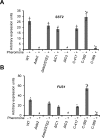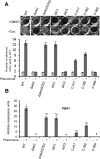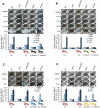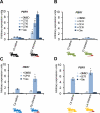Defining pheromone-receptor signaling in Candida albicans and related asexual Candida species
- PMID: 21998194
- PMCID: PMC3237633
- DOI: 10.1091/mbc.E11-09-0749
Defining pheromone-receptor signaling in Candida albicans and related asexual Candida species
Erratum in
- Mol Biol Cell. 2012 Mar;23(6):1140
Abstract
Candida albicans is an important human fungal pathogen in which sexual reproduction is under the control of the novel white-opaque switch. Opaque cells are the mating-competent form, whereas white cells do not mate but can still respond to pheromones, resulting in biofilm formation. In this study, we first define the domains of the α-pheromone receptor Ste2 that are necessary for signaling in both white and opaque forms. Both cell states require the IC loop 3 (IC3) and the C-terminal tail of Ste2 for the cellular response, whereas the first IC loop (IC1) of Ste2 is dispensable for signaling. To also address pheromone-receptor interactions in related species, including apparently asexual Candida species, Ste2 orthologues were heterologously expressed in Candida albicans. Ste2 receptors from multiple Candida clade species were functional when expressed in C. albicans, whereas the Ste2 receptor of Candida lusitaniae was nonfunctional. Significantly, however, expression of a chimeric C. lusitaniae Ste2 receptor containing the C-terminal tail of Ste2 from C. albicans generated a productive response to C. lusitaniae pheromone. This system has allowed us to characterize pheromones from multiple Candida species and indicates that functional pheromone-receptor couples exist in fungal species that have yet to be shown to undergo sexual mating.
Figures










Similar articles
-
Interspecies pheromone signaling promotes biofilm formation and same-sex mating in Candida albicans.Proc Natl Acad Sci U S A. 2011 Feb 8;108(6):2510-5. doi: 10.1073/pnas.1017234108. Epub 2011 Jan 24. Proc Natl Acad Sci U S A. 2011. PMID: 21262815 Free PMC article.
-
pH Regulates White-Opaque Switching and Sexual Mating in Candida albicans.Eukaryot Cell. 2015 Nov;14(11):1127-34. doi: 10.1128/EC.00123-15. Epub 2015 Sep 4. Eukaryot Cell. 2015. PMID: 26342021 Free PMC article.
-
A Candida albicans-specific region of the alpha-pheromone receptor plays a selective role in the white cell pheromone response.Mol Microbiol. 2009 Feb;71(4):925-47. doi: 10.1111/j.1365-2958.2008.06575.x. Epub 2008 Dec 18. Mol Microbiol. 2009. PMID: 19170873
-
Mating in Candida albicans and the search for a sexual cycle.Annu Rev Microbiol. 2005;59:233-55. doi: 10.1146/annurev.micro.59.030804.121310. Annu Rev Microbiol. 2005. PMID: 15910278 Review.
-
Why does Candida albicans switch?FEMS Yeast Res. 2009 Oct;9(7):973-89. doi: 10.1111/j.1567-1364.2009.00562.x. Epub 2009 Aug 7. FEMS Yeast Res. 2009. PMID: 19744246 Review.
Cited by
-
Unraveling How Candida albicans Forms Sexual Biofilms.J Fungi (Basel). 2020 Jan 15;6(1):14. doi: 10.3390/jof6010014. J Fungi (Basel). 2020. PMID: 31952361 Free PMC article. Review.
-
Sexual biofilm formation in Candida tropicalis opaque cells.Mol Microbiol. 2014 Apr;92(2):383-98. doi: 10.1111/mmi.12565. Epub 2014 Mar 19. Mol Microbiol. 2014. PMID: 24612417 Free PMC article.
-
Is There a Relationship Between Mating and Pathogenesis in Two Human Fungal Pathogens, Candida albicans and Candida glabrata?.Curr Clin Microbiol Rep. 2023;10(2):47-54. doi: 10.1007/s40588-023-00192-8. Epub 2023 Apr 22. Curr Clin Microbiol Rep. 2023. PMID: 37151577 Free PMC article. Review.
-
Genetic control of conventional and pheromone-stimulated biofilm formation in Candida albicans.PLoS Pathog. 2013;9(4):e1003305. doi: 10.1371/journal.ppat.1003305. Epub 2013 Apr 18. PLoS Pathog. 2013. PMID: 23637598 Free PMC article.
-
Structure-Activity Relationship of α Mating Pheromone from the Fungal Pathogen Fusarium oxysporum.J Biol Chem. 2017 Mar 3;292(9):3591-3602. doi: 10.1074/jbc.M116.766311. Epub 2017 Jan 18. J Biol Chem. 2017. PMID: 28100777 Free PMC article.
References
Publication types
MeSH terms
Substances
Grants and funding
LinkOut - more resources
Full Text Sources
Molecular Biology Databases

